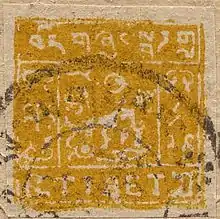| Part of a series on |
| Numeral systems |
|---|
| List of numeral systems |
Tibetan numerals is the numeral system of the Tibetan script and a variety of the Hindu–Arabic numeral system. It is used in the Tibetan language[1][2] and has a base-10 counting system.[3] The Mongolian numerals were also developed from the Tibetan numerals.[4][5]
Cardinal numbers
| Arabic numeral | Tibetan numeral | Tibetan word | Romanisation |
|---|---|---|---|
| 0 | ༠ | ཀླད་ཀོར་ | laykor |
| 1 | ༡ | གཅིག་ | chig [t͡ɕi˥˩] |
| 2 | ༢ | གཉིས་ | nyi [ȵiː˥˥] |
| 3 | ༣ | གསུམ་ | sum [sum˥˥] |
| 4 | ༤ | བཞི་ | shi [ɕi˩˧] |
| 5 | ༥ | ལྔ་ | nga [ŋa˥˥] |
| 6 | ༦ | དྲུག་ | trug [ʈ͡ʂʰu˩˧˨] |
| 7 | ༧ | བདུན་ | dün [tỹ˩˧] |
| 8 | ༨ | བརྒྱད་ | gyay [cɛː˩˧˨] |
| 9 | ༩ | དགུ་ | gu [ku˩˧] |
Extended numbers
| Arabic numeral | Tibetan numeral | Tibetan word | Romanisation |
|---|---|---|---|
| 10 | ༡༠ | བཅུ་ | chu |
| 11 | ༡༡ | བཅུ་གཅིག་ | chu ji |
| 12 | ༡༢ | བཅུ་གཉིས་ | chu nyi |
| 13 | ༡༣ | བཅུ་གསུམ་ | chuk sum |
| 14 | ༡༤ | བཅུ་བཞི་ | chu shi |
| 15 | ༡༥ | བཅུ་ལྔ་ | chü nga |
| 16 | ༡༦ | བཅུ་དྲུག་ | chu druk |
| 17 | ༡༧ | བཅུ་བདུན་ | chup dün |
| 18 | ༡༨ | བཅུ་པརྒྱད | chup gyay |
| 19 | ༡༩ | བཅུ་དགུ་ | chu gu |
| 20 | ༢༠ | ཉི་ཤུ་ | nyi shu |
| 30 | ༣༠ | སུམ་ཅུ | sum ju |
| 40 | ༤༠ | བཞི་བཅུ | ship ju |
| 50 | ༥༠ | ལྔ་བཅུ | ngap ju |
| 60 | ༦༠ | དྲུག་ཅུ | trug chu |
| 70 | ༧༠ | བདུན་ཅུ | dün ju |
| 80 | ༨༠ | བརྒྱད་ཅུ | gyay ju |
| 90 | ༩༠ | དགུ་བཅུ | gup ju |
| 100 | ༡༠༠ | བརྒྱ་ | gya |
| 1,000 | ༡༠༠༠ | སྟོང་ | tong |
| 10,000 | ༡༠༠༠༠ | ཁྲི་ | thri |
| 1,000,000 | ༡༠༠༠༠༠༠ | ས་ཡ་ | sa ya |
| 10,000,000 | ༡༠༠༠༠༠༠༠ | བྱེ་བ་ | che wa |
| 100,000,000 | ༡༠༠༠༠༠༠༠༠ | དུང་ཕྱུར་ | dung chur |
| 1,000,000,000 | ༡༠༠༠༠༠༠༠༠༠ | ཐེར་འབུམ་ | ther pum |
| 10,000,000,000 | ༡༠༠༠༠༠༠༠༠༠༠ | ཐེར་འབུམ་ཆེན་པོ་ | ther pum chen po |
| 100,000,000,000 | ༡༠༠༠༠༠༠༠༠༠༠༠ | ཁྲག་ཁྲིག་ | thrag trig |
| 1,000,000,000,000 | ༡༠༠༠༠༠༠༠༠༠༠༠༠ | ཁྲག་ཁྲིག་ཆེན་པོ་ | thrag trig chen po |
Ordinals
| Arabic numeral | Tibetan numeral | Tibetan ordinal word | Romanisation |
|---|---|---|---|
| 1 | ༡ | དང་པོ་ | dang po [tʰaŋ˩˧.ko˥˥] |
| 2 | ༢ | གཉིས་པ་ | nyi pa |
| 3 | ༣ | གསུམ་པ་ | sum pa |
| 4 | ༤ | བཞི་པ་ | shi pa |
| 5 | ༥ | ལྔ་པ་ | nga pa |
| 6 | ༦ | དྲུག་པ་ | trug pa |
| 7 | ༧ | བདུན་པ་ | dün pa |
| 8 | ༨ | བརྒྱད་པ་ | gyay pa |
| 9 | ༩ | དགུ་པ་ | gu pa |
| 10 | ༡༠ | བཅུ་པ་ | chu pa |
Fractions
Several slashed forms of Tibetan numerals are included in Unicode to represent fractions. However, their exact meaning and authenticity are unclear.[6]
| Tibetan fractions | ༳ | ༪ | ༫ | ༬ | ༭ | ༮ | ༯ | ༰ | ༱ | ༲ |
|---|---|---|---|---|---|---|---|---|---|---|
| Values | -0.5 | 0.5 | 1.5 | 2.5 | 3.5 | 4.5 | 5.5 | 6.5 | 7.5 | 8.5 |
See also
References
- ↑ "Tibetan (བོད་སྐད)". Omniglot. Retrieved 19 December 2020.
- ↑ "Numbers in Tibetan". Omniglot. Retrieved 19 December 2020.
- ↑ Tournadre, Nicolas; Dorje, Sangda (2003). Manual of Standard Tibetan: Language and civilization. Ithaca, N.Y.: Snow Lion Publications. ISBN 1559391898. OCLC 53477676.
- ↑ Chrisomalis, Stephen (2010). Numerical Notation: A Comparative History. Cambridge University Press. ISBN 9780521878180.
- ↑ "The Unicode® Standard Version 10.0 – Core Specification: South and Central Asia-II" (PDF). Unicode.org. Retrieved 3 December 2017.
- 1 2 "Numbers that Don't Add up – Tibetan Half Digits". BabelStone. Retrieved 4 December 2022.
External links
- Mazaudon & Lacito, 2002, "Les principes de construction du nombre dans les langues tibeto-birmanes", in François, ed. La Pluralité
This article is issued from Wikipedia. The text is licensed under Creative Commons - Attribution - Sharealike. Additional terms may apply for the media files.
